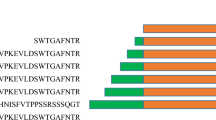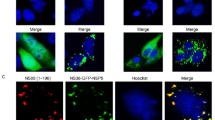Abstract
HCV and related viruses are now classified as a separate genus in the family Flaviviridae (1), which includes two other genera, Flavivirus (2), and Pestivirus (3). The positive-strand HCV genome RNA is approx 9.4 kb in length and contains a highly conserved 5′ noncoding region followed by a long open reading frame encoding a polyprotein of 3010–3033 amino acids (4,5) Recently, it was determined that the 3′ end contains another highly conserved noncoding region approx 100 bp in length (6–8). Because a cell-culture system supporting efficient HCV replication is lacking, efforts to define potential HCV-encoded polypeptides have utilized expression of HCV cDNA in cell-free translation systems and in cell cultures. The HCV polyprotein appears to be cleaved at multiple sites to produce at least 10 structural and nonstructural (NS) proteins (9). The order and nomenclature of these cleavage products for the HCV-H strain are NH2-C-El-E2-p7-NS2-NS3-NS4A-NS4B-NS5A-NS5B-COOH, where C, El, and E2 are putative structural proteins and the remaining NS proteins are believed to be replicase components (9–12). Host signal peptidase in the endoplasmatic reticulum lumen appears to catalyze cleavages in the structural-NS2 region (C/El, E1/E2, E2/p7, and p7/NS2 sites) (9,13), whereas an HCV-encoded serine proteinase located in the N-termmal one-third of the NS3 protein is responsible for four cleavages in the NS region (3/4A, 4A/4B, 4B/5A, and 5A/5B sites) (11,14–16).
Access this chapter
Tax calculation will be finalised at checkout
Purchases are for personal use only
Similar content being viewed by others
References
Rice, C. M (1996) Flavivindae: the viruses and their replication, in Fields Virology, vol. 1 (Fields, B N., Knipe, D. M., and Howley, P M, eds), Lippincott-Raven, Philadelphia, pp. 931–959
Monath, T. P. and Heinz, F. X. (1996) Flaviviruses, in Fields Virology, vol 1 (Fields, B N., Knipe, D. M., and Howley, P M., eds), Lippincott-Raven, Philadelphia, pp 961–1034.
Thiel, H J., Plagemann, P G. W, and Moennig, V (1996) Pestiviruses, in Fields Virology, vol. 1 (Fields, B. N., Knipe, D M., and Howley, P M., eds), Lippincott-Raven, Philadelphia, pp. 1059–1073
Houghton, M., Werner, A, Han, J, Kuo, G, and Choo, Q.-L (1991) The hepatitis C virus encodes a serine protease involved in processing of the putative nonstructural proteins from the viral polyprotein precursor Hepatology 14, 381–388.
Matsuura, Y. and Miyamura, T. (1993) The molecular biology of hepatitis C virus Semin Virol 4, 297–304
Kolykhalov, A A, Feinstone, S M., and Rice, C. M (1996) Identification of a highly conserved sequence element at the 3′ terminus of hepatitis C virus genome RNA. J Virol 70, 3363–3371.
Tanaka, T., Kato, N., Cho, M.-J, and Shimotohno, K. (1995) A novel sequence found at the 3′ terminus of hepatitis C virus genome. Biochem Biophys Res Commun. 215, 744–749.
Tanaka, T., Kato, N., Cho, M.-J., Sugiyama, K., and Shimotohno, K. (1996) Structure of the 3′ terminus of the hepatitis C virus genome. J Virol. 70, 3307–3312.
Lin, C, Lindenbach, B D, Prágai, B., McCourt, D W, and Rice, C. M. (1994) Processing of the hepatitis C virus E2-NS2 region: identification of p7 and two distinct E2-specific products with different C termini. J Virol 68, 5063–5073
Grakoui, A., Wychowski, C., Lin, C., Feinstone, S. M., and Rice, C M. (1993) Expression and identification of hepatitis C virus polyprotein cleavage products J. Virol 67, 1385–1395.
Grakoui, A, McCourt, D. W, Wychowski, C, Feinstone, S. M, and Rice, C. M (1993) Characterization of the hepatitis C virus-encoded serine proteinase determination of proteinase-dependent polyprotein cleavage sites J Virol 67, 2832–2843
Grakoui, A., McCourt, D W., Wychowski, C, Feinstone, S. M, and Rice, C. M. (1993) A second hepatitis C virus-encoded proteinase Proc Natl Acad Sci USA 90, 10,583–10,587.
Hijikata, M., Kato, N, Ootsuyama, Y., Nakagawa, M, and Shimotohno, K (1991) Gene mapping of the putative structural region of the hepatitis C virus genome by in vitro processing analysis Proc Natl Acad Sci. USA 88, 5547–5551
Bartenschlager, R., Ahlborn-Laake, L., Mous, J, and Jacobsen, H (1993) Nonstructural protein 3 of the hepatitis C virus encodes a senne-type proteinase required for cleavage at the NS3/4 and NS4/5 junctions J Virol 67, 3835–3844
Eckart, M. R., Selby, M, Masiarz, F., Lee, C, Berger, K., Crawford, K., et al (1993) The hepatitis C virus encodes a serine protease involved in processing of the putative nonstructural proteins from the viral polyprotein precursor. Biochem Biophys Res Commun 192, 399–406
Hijikata, M, Mizushima, H, Akagi, T., Mori, S, Kakiuchi, N., Kato, N, et al (1993) Two distinct proteinase activities required for the processing of a putative nonstructural precursor protein of hepatitis C virus J Virol 67, 4665–4675
Fuerst, T. R, Niles, E. G., Studier, F. W., and Moss, B. (1986) Eukaryotic transient-expression system based on recombinant vaccinia virus that synthesizes bacteriophage T7 RNA polymerase Proc Natl. Acad Sci USA 83, 8122–8126
Elroy-Stein, O., Fuerst, T. R., and Moss, B, (1989) Cap-independent translation of mRNA conferred by encephalomyocarditis virus 5′ sequence improves the performance of the vaccinia virus/bactenophage T7 hybrid expression system. Proc Natl Acad Sci. USA 86, 6126–6130.
Moss, B., Elroy-Stein, O, Mizukami, T, Alexander, W A, and Fuerst, T. R. (1990) New mammalian expression vectors. Nature (Lond) 348, 91,92.
Richmond, J. Y. and McKinney, R. W. (1993) Biosafety, in Microbiological and Biomedical Laboratories, US Department of Health and Human Services, Washington, DC, p 177
Moss, B (1996) Genetically engineered pox viruses for recombinant gene expression, vaccination, and safety Proc Natl Acad. Sci USA 93, 11,341–11,348
Britton, P., Green, P., Kottier, S., Mawditt, K L., Penzes, Z., Cavanagh, D, et al (1996) Expression of bacteriophage T7 RNA polymerase in avian and mammalian cells by a recombinant fowlpox virus. J. Gen Virol 77, 963–967.
Sutter, G. and Moss, B. (1992) Nonreplicating vaccinia vector efficiently expresses recombinant genes. Proc. Natl Acad. Sci USA 89, 10,847–10,851
Kolykhalov, A A, Agapov, E V, and Rice, C M (1994) Specificity of the hepatitis C virus serine proteinase. Effects of substitutions at the 3/4A, 4A/4B, 4B/5A, and 5A/5B cleavage sites on polyprotein processing. J Virol 68, 7525–7533
Author information
Authors and Affiliations
Editor information
Editors and Affiliations
Rights and permissions
Copyright information
© 1998 Humana Press Inc., Totowa, NJ
About this protocol
Cite this protocol
Agapov, E.V., Reed, K.E., Rice, C.M. (1998). Use of the Vaccinia Virus/T7 Expression System for Studying HCV Protein Processing. In: Lau, J.YN. (eds) Hepatitis C Protocols. Methods in Molecular Medicine™, vol 19. Humana Press. https://doi.org/10.1385/0-89603-521-2:303
Download citation
DOI: https://doi.org/10.1385/0-89603-521-2:303
Publisher Name: Humana Press
Print ISBN: 978-0-89603-521-8
Online ISBN: 978-1-59259-260-9
eBook Packages: Springer Protocols




